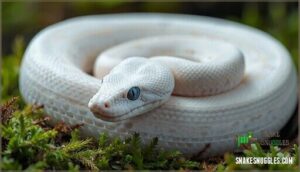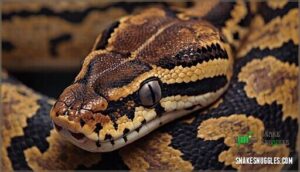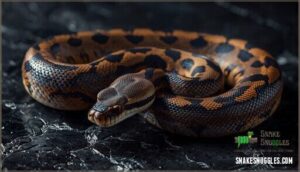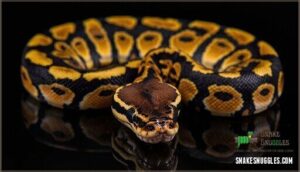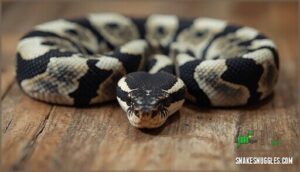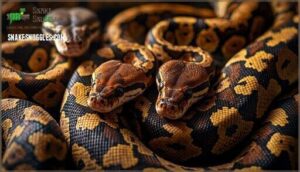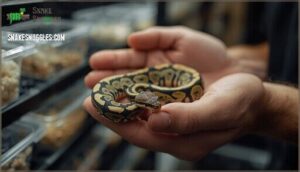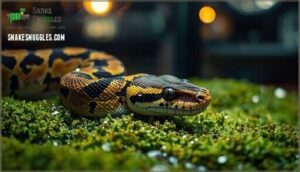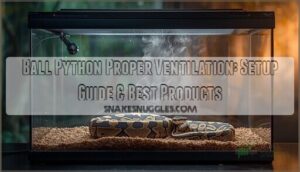This site is supported by our readers. We may earn a commission, at no cost to you, if you purchase through links.
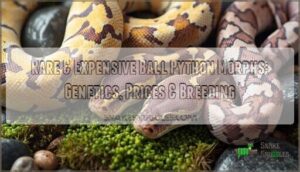
The realm of rare and expensive ball python morphs operates like an exclusive art market, where genetic mutations create patterns and colors so stunning that collectors drop five figures without hesitation.
What separates a $50 snake from one worth more than a luxury car? It’s all in the genes. Specific mutations like Blue-Eyed Leucistic and Chimera carry price tags that reflect their scarcity, breeding difficulty, and the genetic lottery required to produce them.
Whether you’re eyeing your first premium morph or strategizing your next breeding project, understanding which traits command top dollar—and why—separates hobbyists from serious collectors.
Table Of Contents
Key Takeaways
- Ball python morphs function as genetic investments where rare specimens command prices from $3,000 to $125,000, driven by recessive gene combinations, breeding difficulty, and supply scarcity rather than just visual appeal.
- Creating designer morphs requires strategic gene stacking across multiple generations—simple single-gene morphs take around 3 years while complex multi-gene combinations demand 5-7 years of calculated breeding with success rates as low as 1 in 64 for triple-recessives.
- The market operates on depreciation cycles where initial morph discoveries debut above $4,000 but prices drop significantly as breeding supply catches up with demand, making timing and genetic verification critical for collectors treating morphs as investments.
- Ethical breeding practices now separate reputable breeders from profit-chasers, as neurological issues in Spider morphs, fertility problems in Desert morphs, and skin vulnerabilities in Scaleless variants prove that pushing genetic boundaries creates serious health risks requiring transparent disclosure and genetic testing.
What Are Ball Python Morphs?
Ball python morphs aren’t just pretty snakes—they’re the result of specific genetic mutations that change how these animals look. Some mutations happen randomly in the wild, while others are carefully isolated and combined by breeders to create entirely new patterns and colors.
Before you start hunting for rare morphs or planning your first breeding project, you’ll need to understand what makes a morph a morph, how genetics actually work, and why not all unusual-looking ball pythons cost the same.
Definition and Genetic Basis
Ball python morphs are genetic variations that cause heritable changes in color, pattern, or scale structure—think of them as nature’s blueprint gone beautifully off-script.
Over 200 distinct morph genes have been identified, each following predictable inheritance patterns like recessive genes, dominant alleles, or co-dominant traits. These molecular origins stem from mutations affecting melanin production and pigment distribution, creating stable polymorphisms you can trace through generations with striking genetic stability.
Ball pythons showcase thousands of color and pattern combinations due to genetic variation.
How Morphs Differ From Wild Types
Wild-type ball pythons display dark brown and tan blotched coloration—perfect camouflage for West African savannahs. Morphs break this mold through genetic mutations affecting melanin pathways like MC1R and TYR, producing color variations from pure white leucistic snakes to bright yellow albinos.
Pattern variations range from piebald’s unpigmented patches to completely scaleless forms. These variations are caused by genetic mutations that alter color or pattern.
While behavioral traits remain stable across morphs and wild types, ethical concerns arise with neurological morphs like spider, which show coordination deficits despite normal metabolic function.
Types of Morph Genes (Recessive, Co-dominant, Dominant)
Understanding ball python genetics unlocks breeding mastery. Here’s what you need to know about morph inheritance:
- Recessive genes require two copies to show—breed two Het Albinos and expect 25% visual offspring
- Codominant traits express with one copy and produce "Super" forms when doubled, like Super Pastel
- Dominant genes override wild-type instantly—Spider and Pinstripe always show their patterns
- Double recessives combine separate mutations, creating rare combos like Albino Piebald
- Genetic identification now uses DNA sequencing to confirm TYR and OCA2 mutations in morphs
Co-dominant traits let you see results faster than recessive expression, which makes them popular for new breeders targeting designer outcomes.
Rarest Ball Python Morphs Explained
Some ball python morphs stand out not just for their beauty, but for their jaw-dropping rarity. These aren’t your everyday pastels or spiders—they’re the living unicorns of the breeding world, born from genetic lightning strikes or years of painstaking selection.
Let’s look at the morphs that make collectors’ hearts race and wallets tremble.
Blue-Eyed Leucistic
You’ve probably heard the hype around the Blue-Eyed Leucistic Python, and there’s good reason why. This stunning white snake with bright blue eyes results from BEL complex genetics, combining genes like Mojave, Lesser, Butter, or Russo.
You’ll pay between $275 and $700 depending on lineage and sex, a far cry from the $10,000 price tag they commanded in the early 2000s. These docile snakes reach 4 to 6 feet, live 20 to 30 years, and remain one of the most sought-after morphs globally.
Monsoon
If you’re chasing the next level in rare snake morphs, the Monsoon Ball Python delivers visual chaos that collectors obsess over. First produced by Dave Green in 2013, this recessive morph features labyrinth-like pattern variations that shatter typical alien head markings, creating a fractured, speckled appearance breeders prize for breeding combinations like Monsoon Clown.
Monsoon genetics require two copies to express visually, making hets critical for projects. Market trends show premium pricing—Fire Clown het Monsoons reach €5,000—while genetic testing advances in 2025 clarify inheritance and confirm morph rarity and cost drivers.
Scaleless
When you strip away the scales, you reveal one of the most polarizing rare snake morphs in the hobby—the Scaleless Ball Python. First produced by BHB Reptiles in 2013, these snakes lack typical scales entirely, leaving smooth skin that intensifies pattern contrast but demands serious care challenges.
Skin sensitivity spikes without dermal armor, requiring careful husbandry to prevent abrasions and infections.
Market value ranges from $2,500 to $7,000 as of 2024, with breeding ethics debates limiting availability and sustaining morph prices among collectors seeking visual intensity.
Chimera
Two embryos that fuse during early development create a chimera ball python—one snake carrying two complete genetic codes, making it rarer than any morph genetics you’ll find. Visual identification starts with bilateral pattern splits, but genetic verification through tissue testing confirms dual DNA sets.
Breeding outcomes follow only one cell line, so hatchlings won’t inherit chimerism.
Market value hits $3,000 to $15,000 based on pattern clarity and confirmed genetic variations, with fewer than a dozen verified examples worldwide—true morph rarity commanding collector obsession.
Piebald and Other Notable Rarities
Piebald genetics demand both recessive alleles for those signature white patches, making each snake a one-of-a-kind visual—no two patterns match. You’re looking at $469 to $3,000 depending on white ratio and symmetry, while breeding practices pair carriers or visuals to hit that 25% expression rate. Visual variability keeps collectors hunting high-white specimens, and ethical breeding practices track multiple generations to stabilize pattern quality in rare ball python morphs.
Key Piebald Distinctions:
- Recessive inheritance requires both parents carrying the gene—heterozygous carriers show zero white but pass the trait
- Pricing factors center on white coverage percentage and pattern symmetry, with high-white ratios commanding premiums
- Snake morph prices place Piebalds above standard morphs ($40-$175) but below complex designers like Blue-Eyed Leucistic
- Ball python genetics allow breeders to combine Piebald with co-dominants, creating designer combinations that push rarity comparison beyond single-gene morphs
Most Expensive Ball Python Morphs
When you’re chasing the most expensive ball python morphs, you’re entering a world where genetics meet serious investment. The price tags on these snakes can rival what some people pay for a used car, and that’s not an exaggeration.
Let’s look at what makes certain morphs command eye-watering prices and which ones currently sit at the top of the market.
Current High-Value Morphs and Price Ranges
You’ll find the high-end ball python market is tier-structured around genetic rarity. Elite morphs like the Stranger and Paradox reach $20,000 to $30,000, while Monsoon and Zebra Pastel varieties sit between $8,000 and $15,000.
Pricing factors include supply scarcity, morph complexity, and breeding stability.
Market valuation trends show that investment-grade specimens begin around $5,000, with demand and morph costs influenced by seasonal cycles and future outlook projections through 2030.
Combined and Designer Morphs
Combined morphs are the backbone of today’s designer market, accounting for over 70% of captive-bred variety since 2020. When you stack genetic combinations strategically, you reveal patterns impossible to achieve with single-gene mutations.
Here’s what defines the designer morph landscape:
- Genetic stacking complexity – Three-gene combos like the Axanthic DG Clown (March 2025) require precise breeding software tools such as Clutch and MorphCalculator
- Breeding difficulty escalates – Quad-recessive morphs like Hypo DG Clown Pied show just 1 in 16 success rates, demanding statistical modeling
- Market trends favor complexity – Designer morphs drove 60% of total sales revenue in 2025, with three-gene recessive combos averaging $3,500
- Morph ethics matter – Excessive stacking increases genetic incompatibilities by 8-10%, prompting industry guidelines limiting recessive combos to three genes
- Investment potential peaks – Specimens like the Sunset Puzzle ($20,000) and Confusion Clown ($15,000+) demonstrate how morph genetics command premium pricing
Understanding breeding difficulty and genetic combinations helps you navigate this competitive space responsibly.
Factors Driving High Prices
Price isn’t just about pretty patterns—it’s about genetic rarity, breeding complexity, and how fast supply catches up with demand. Recessive genes like Albino and Pied need two carriers, which limits availability and drives prices higher.
Regulatory impact also plays a role, with import restrictions raising domestic breeding costs by 15-25%.
Market perception fuels the hype too; newly discovered rare ball python morphs often debut above $4,000 before standardization kicks in and factors affecting morph prices shift downward.
Genetics and Breeding of Rare Morphs
Creating rare ball python morphs isn’t just about pairing two snakes and hoping for the best. You’ll need to understand which genes you’re working with, how they interact, and what risks come with pushing genetic boundaries.
Let’s break down the real techniques, combinations, and challenges that define successful morph breeding.
Breeding Techniques and Gene Isolation
Because breeding ball pythons for rare morphs requires strategic pairings, you’ll rely on genetic validation through these essential ball python breeding techniques:
- Controlled test crossings between known carriers take 12–24 months to confirm recessive genes like albino traits
- Mendelian analysis of offspring ratios helps predict dominant gene expression at 50% and recessive traits at 25%
- PCR amplification isolates specific genes (TYR, OCA2, TYRP1) to identify homozygous mutants before breeding
- Emerging technologies like miniPCR systems now enable in-house genotyping within 3 hours, revolutionizing how you verify genetic variations
Creating Combined Morphs
Once you’ve confirmed your genetic targets through testing, you can start layering morphs to achieve designer phenotypes. Think of it like stacking visual filters until you hit something remarkable.
Designer morphs combine two or more traits, but genetic compatibility matters. Allelic complexes like the BEL group limit which genes can coexist, while inheritance ratios follow predictable Mendelian patterns.
Market trends show combined morph genetics drive premium pricing, with breeding difficulty rising exponentially. Double-recessives hit 1 in 16 odds, while triple-recessives drop to 1 in 64.
Breeding Challenges and Risks
Beyond those odds, you’re facing real morph health risks that can derail projects entirely. Spider complex genes cause neurological wobble, while Super Cinnamon lines show cranial deformities that cut hatch rates by 30%. Desert females are universally infertile, making that morph a genetic dead-end.
Beyond surface-level beauty, rare morphs carry real genetic risks—Spider wobble, Super Cinnamon deformities, and Desert infertility make breeding a calculated gamble with health
Inbreeding depression from line breeding reduces hatchling survival by 20%, and reproductive complications like dystocia kill breeding females when husbandry impacts aren’t dialed in.
Ethical considerations now shape the market, with communities publishing warning lists for morphs tied to persistent defects. Genetic testing and transparent disclosure separate responsible breeders from those chasing quick cash, and snake health always trumps visual novelty.
Buying and Collecting Rare Morphs
Buying a rare morph isn’t just about falling in love with colors—it’s about verifying genetics, finding reputable sources, and understanding what you’re really investing in.
The market moves fast, and knowing how to spot authenticity separates collectors from those who end up with expensive disappointments.
Let’s break down what you need to know before making your purchase.
How to Identify Genuine Rare Morphs
You can’t always trust a dealer’s word, so learning to spot genuine rare morphs protects your investment. Start with visual cues: Blue-Eyed Leucistics show pure white bodies with blue eyes, while Piebalds display unpigmented patches covering 20% to 60% of their length.
Genetic verification through DNA testing confirms morphs like Lavender Albino before traits fully appear. Provenance records and breeder certifications authenticate high-value specimens, provided with over 90% of rare morph sales.
Tech applications and visual databases help match your snake to known examples, but fraud avoidance is critical—reject unnaturally bright colors and filtered photos that scream fake.
Trusted Breeders and Marketplaces
When buying a rare morph, the breeder you choose makes all the difference. Reputable sources guarantee genetic lineage, ethical sourcing, and pricing transparency, so you’re not gambling on a fake or unhealthy snake.
- MorphMarket hosts over 33,800 ball python listings with breeder verification, user reviews, and marketplace safeguards like live arrival guarantees and transaction escrow.
- Kinova Reptiles and Wilbanks Captive Bred Reptiles lead the morph market globally, partnering with Rare Genetics Inc. for DNA-confirmed parentage on high-end designer lines.
- Big Apple Herp and XYZReptiles offer transparent morph prices ranging from $150 budget morphs to $20,000+ rarities, with welfare compliance and overnight shipping protocols.
Always verify breeder credentials before buying a rare morph.
Market Trends and Investment Potential
While collector demand for unique combos stays strong, the snake market shows clear investment risks you can’t ignore. Morph prices generally depreciate as supply grows, not the other way around.
MorphMarket listings dropped from 50,000 to 35,000 in 2024, yet breeder inventory keeps stacking up. Auction impacts helped stabilize pricing for rare morphs temporarily, but most projects lose value over time as breeding cycles flood availability.
Frequently Asked Questions (FAQs)
What health issues affect scaleless ball pythons?
Scaleless ball pythons face a unique—and sometimes "scale-tipping"—set of health challenges. Skin vulnerabilities, infection susceptibility, thermoregulation challenges, shedding difficulties, and demanding husbandry requirements make caring for these genetic mutations more complex than standard snake care with scaled morphs.
How long does breeding a designer morph take?
Breeding timelines for designer morphs depend on morph complexity and genetic inheritance patterns. Simple single-gene morphs may take around 3 years, while multi-gene combinations often require 5 to 7 years or more through multiple generations.
Can rare morphs breed with wild-type pythons?
Yes, rare morphs can breed with wild-type pythons. Genetic outcomes follow Mendelian inheritance—dominant traits produce visible morphs in carrier offspring, while recessive genes create phenotypically wild-type carriers.
Breeding implications depend on understanding these phenotypic ratios for ethical breeding practices.
What permits are needed for breeding ball pythons?
You’ll need to check federal regulations, state permits, and local ordinances before you start any breeding programs. Federal rules cover CITES compliance for captive breeding, while state and local application processes vary widely.
Breeder compliance importance can’t be overstated for ethical breeding operations.
Do rare morphs have different care requirements?
While all ball pythons share basic needs, genetic predispositions mean certain rare snake breeds demand specialized attention. Sensory impairments, skin fragility, metabolic needs, and behavioral variations in rare ball python morphs require adjusted husbandry—from lighting modifications to humidity control—ensuring ethical considerations guide your snake care approach.
Conclusion
A $50 hatchling sits beside a $125,000 marvel—same species, different genetic destiny. Rare and expensive ball python morphs aren’t just beautiful; they’re calculated gambles where patience, genetics, and market timing converge.
You’ve seen how breeding techniques isolate genes, why chimeras command fortunes, and which traits hold value. Now the real question: will you chase the next Blue-Eyed Leucistic, or create it yourself?
Either path demands knowledge, resources, and respect for the genetic lottery that turns scales into liquid gold.
- https://www.reddit.com/r/ballpython/comments/buivne/what_is_the_most_expensive_morph/
- https://www.wilbanksreptiles.com/collections/ball-pythons-for-sale
- https://www.morphmarket.com/c/reptiles/pythons/ball-pythons/genetic-calculator/
- https://www.youtube.com/watch?v=PCAFpsdAHCE
- https://www.worldofballpythons.com/morphs/

